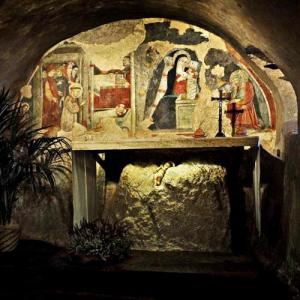The Shrine of Greccio
Known as the Franciscan Bethlehem, the shrine is an imposing architectural compound which clings to the bare rock.
The original core of the shrine is the Cappella del Presepio (Nativity Chapel), built in 1228, the year of Saint Francis’ canonisation. The chapel stands over the grotto where, on Christmas Eve 1223, Saint Francis, with the authorisation of the Pope and the help of Messer Giovanni Velita, a lord in Greccio, re-enacted the birth of Jesus for the first time in the history of Christianity, thereby establishing the first nativity play. The chapel is a grotto excavated in the stone, with a semi-circular vault.
The bare stone where the Saint laid down the simulacrum of Jesus can be seen below the modern-style altar, while a fine fresco by the school of Giotto can be found on the wall at the back. Its two scenes represent the Nativity in Greccio and the Nativity in Bethlehem, with the Virgin Mary breastfeeding Jesus. In the lunette, Mary Magdalene, protector of the hermits, is depicted.
The Nativity Scene in Greccio is similar to the fresco that Giotto painted on the same subject in the Upper Basilica of Assisi; Francis, wearing the deacon's white dalmatic, adores Jesus on his knees, while at the top right, the priest officiates the mass.
Behind Francis, the other participants in the event can be seen; in the foreground a man in a long red tunic, who according to local tradition is Giovanni Velita, a lord in Greccio and descendant of the Berardi di Celano counts, who became a very good friend of Francis, and on his left, his wife Alticama Castelli di Strocone and the people of Greccio.
The ancient walls of the shrine safeguard numerous treasures.




























